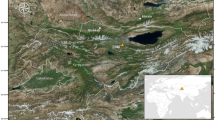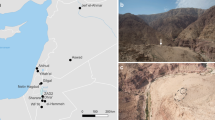Abstract
Analyses of charred remains and impressions of chaff in pisé (mudbrick) from the Neolithic sites of Aratashen and Aknashen (sixth millennium cal b.c.) situated in the Ararat valley in Armenia demonstrate that naked barley and possible naked (free-threshing) wheat together with emmer and hulled barley were common. Two lesser known crucifers, Camelina microcarpa (false flax) and Alyssum desertorum (alyssum) were found in the form of crop processing residues. These were frequent in the pisé, indicating their use perhaps as an oil source. Lens culinaris (small-seeded lentil) and Vicia ervilia (bitter vetch) were recovered both as carbonized seeds and from crop processing residues in the pisé. False flax and bitter vetch were less common than alyssum and lentil. Two charred pips of Vitis vinifera (wild vine) were recovered, suggesting the early use of vines in the region. Flotation samples alone would have provided limited data; examination of crop processing residues used for tempering pisé provided important evidence of the plant economy at these two sites.




Similar content being viewed by others
References
Avetisyan P, Chataigner C, Palumbi J (2006) The results of the excavations in Nerkin Godedzor (2005–2006) Preliminary report. "Aramazd”. Armen J Near East Stud 1:6–10
Badalyan R, Lombard P, Avetisyan P, Chataigner C, Chabot J, Vila E, Hovsepyan R, Willcox G, Pessin H (2007) New data on the late prehistory of the Southern Caucasus. The excavations at Aratashen (Armenia): preliminary report. In: Lyonnet B (ed) Les cultures du Caucase (VIe-IIIe millénaires avant notre ère. Leurs relations avec le Proche-Orient). CNRS Éditions, Paris, pp 37–61
Baghdasaryan AB (1962) Climate. In: Geology of Armenian SSR, vol 1 (Geomorphology), Ac. Sci. Arm. SSR Publ., Yerevan (in Russian)
Braadbaart F (2008) Carbonisation and morphological changes in modern dehusked and husked Triticum dicoccum and Triticum aestivum grains. Veg Hist Archaeobot 17:155–166
Buxo R (2007) Crop evolution: new evidence from the Neolithic of west Mediterranean Europe. In: Colledge S, Conolly J (eds) The origin and spread of domestic plants in southwest Asia and Europe. Left Coast Press, Walnut Creek, pp 155–171
Czerepanov SK (1995) Sosudistye rastenia Rossii I sopredelnykh gosudarstv (vascular plants of Russia and contiguous states, in Russian). Mir i semia-95, Saint Petersburg
Dobrochotov VN (1961) Semena sorniakov (seeds of weeds, in Russian). Selkhozizdat, Moscow
Dorofeev VF, Yakubtsiner MM, Rudenko MI, Migushova EF, Udachin RA, Merejko AF, Semenova LV, Novikova MV, Gradchaninova OD, Shitova IP (1976) Pshenitsi mira (Wheats of the world, in Russian). Kolos, Leningrad
Dorofeev VF, Filatenko AA, Migushova EF, Udachin RA, Yakubtsiner MM (1979) Flora kulturnykh rastenij (Flora of cultivated plants) vol 1. In: Dorofeev VF, Korovina ON (eds) Pshenitsa (Wheat, in Russian). Kolos, Leningrad
Fairbairn A, Martinoli D, Butler A, Hillman G (2007) Wild plant seed storage at Neolithic Çatalhöyük East, Turkey. Veg Hist Archaeobot 16:467–479
Gandilyan PA (1980) Opredelitel pshenitsi, egilopsa, rdzi i iachmenia (Identifier of wheat, aegilops, rye and barley, in Russian). AS Arm SSR, Yerevan
Gandilyan PA (1997) Archaeobotanical evidence for evolution of cultivated wheat and barley in Armenia. In: Damania A, Valkoun J, Willcox G, Qualset C (eds) Origins of agriculture and crop domestication. ICARDA, Aleppo, Syria, pp 280–285
Jacomet S (2006a) Identification of cereal remains from archaeological sites, 2nd edn. IPAS, Basel University
Jacomet S (2006b) Plant economy of the northern Alpine lake dwelling area—3500-2400 cal BC. In: Karg S, Baumeister R, Schlichtherle H, Robinson DE (eds) Economic and environmental changes during the 4th and 3rd Millennia BC. Proceedings of the 25th Symposium of the AEA, Sept. 2004, Bad Buchau, Germany. Environmental Archaeology vol. 11, pp. 64–83
Jacomet S (2007) Neolithic plant economies in the northern alpine foreland from 5500–3500 cal BC. In: Colledge S, Conolly J (eds) The origins and spread of domestic plants in southwest Asia and Europe. Left Coast Press, Walnut Creek, pp 221–258
Janushevich ZV (1976) Kulturnye rastenia iugo-zapada SSSR po paleobotanicheskim dannym (Culture plants of south-west of USSR by palaeobotanical studies, in Russian). Shtiintsa, Kishinev
Janushevich ZV (1984) The specific composition of wheat finds from ancient agricultural centres in the USSR. In: Van Zeist W, Casparie WA (eds) Plants and ancient man: studies in palaeoethnobotany. Balkema, Rotterdam, pp 267–276
Kats NJ, Kats SV (1946) Atlas i opredelitel plodow i semian wstrechaemykh v torfe i ilakh (Atlas and identifier of fruits and seeds from peat and mud, in Russian). MSNI, Moskva
Lisitsina GN (1984) The Caucasus—a centre of ancient farming in Eurasia. In: Van Zeist W, Casparie WA (eds) Plants and ancient man: studies in palaeoethnobotany. Balkema, Rotterdam, pp 285–292
Lisitsina GL, Prishchepenko LV (1977) Paleoetnobotanicheskie nakhodki Kavkaza i Blizhnego Vostoka (Palaeoethnobotanical finds of Caucasus and Near East, in Russian). Nauka, Moscow
Lukjanova MV, Trofimovskaja AJ, Gudkova GN, Terenteva IA, Jarosh NP (1990) Flora kulturnykh rastenij (Flora of cultivated plants), vol 2, part 2, Iachmen (Barley, in Russian). Agropromizdat, Leningrad
Maier U (1996) Morphological studies of free-threshing wheat ears from a Neolithic site in southwest Germany, and the history of the naked wheats. Veg Hist Archaeobot 5:39–55
Maier U (2001) Archäobotanische Untersuchungen in der neolithischen Ufersiedlung Hornstaad-Hörnle IA am Bodensee. In: Maier U, Vogt R (eds) Siedlungsarchäologie im Alpenvorland VI. Botanische und pedologische Untersuchungen zur Ufersiedlung Hornstaad-Hörnle IA. (Forsch Ber Vor- Frühgesch Bad-Württ 74). Theiss, Stuttgart, pp 9–384
Maysuryan NA, Atabekova AI (1931) Opredelitel plodov i semian sorniakov (Identifier of seeds and fruits of weeds, in Russian). Selkhozizdat, Moscow-Leningrad
Nergul AM (1960) Arkheologicheskie nakhodki kostochek vinograda (Archaeological finds of grape pips, in Russian). Soviet archaeology 1:111–119
Nesbitt M (2002) When and where did domesticated cereals first occur in southwest Asia? In: Cappers RTJ, Bottema S (eds) The dawn of farming in the Near East (studies in near Eastern production, subsistence and environment 6). ex oriente, Berlin, pp 113–132
Schlichtherle H (1981) Cruciferen als Nutzpflanzen in neolithischen Ufersiedlungen Südwestdeutschlands und der Schweiz. Zeitschr Archäol 15:113–124
Stoletova EA (1930) Field and garden cultigens of Armenia, in Russian. Bulletin of applied botany, of genetics and plant-breeding 4(23):1–378
Takhtajyan AL, Fedorov AA (1972) Flora Erevana (Flora of Yerevan, in Russian). Nauka, Leningrad
Takhtajyan AL (ed) (1954–2001) Flora Armenii (Flora of Armenia, in Russian), vol 1 (1954); vol 2 (1956); vol 3 (1958); vol 4 (1962); vol 5 (1966); vol 6 (1973); vol 7 (1980); vol 8 (1987). AS Arm SSR, Yerevan; vol 9 (1995). Koeltz Scientific Books; vol 10 (2001). ARG Grantner Verlag KG Ruggell, Liechtenstein
Terrell EE, Peterson PM (1993) Caryopsis morphology and classification in the Triticeae (Pooideae: Poaceae). Smithsonian contributions in botany 83:25
Tumanyan MG (1944) Kulturnye rastenia Urartskovo vremeni v Arm. SSR (Urartian period crop in Armenian SSR, in Russian). Notices of AS of USSR (Social sciences), Ac. Sci. Arm. SSR 1–2:73–82
Wasylikowa K, Carciumaru M, Hajnalova E, Hartyanyi BP, Pashevich A, Yanushevich ZV (1991) East-Central Europe. In: Van Zeist W, Wasylikowa K, Behre K-E (eds) Progress in old world palaeoethnobotany. Balkema, Rotterdam, pp 207–239
Willcox G (1991) Carbonised plant remains from Shortughai. In Renfrew J (ed) New light on early farming, Edinburgh University Press, pp 139–154
Willcox G, Fornite S, Herveux LH (2007) Early Holocene cultivation before domestication in northern Syria. Veg Hist Archaeobot. doi:10.1007/s00334-007-0121-y
Zohary D, Hopf M (2000) Domestication of plants in the old world: the origin and spread of cultivated plants in West Asia, Europe and the Nile Valley, 3rd edn. Oxford University Press, Oxford
Acknowledgements
This study is supported by the C.N.R.S. (National Centre of Scientific Research) and the French Ministry of Foreign Affairs. The authors thank all participants of the Armenian-French expedition for help during fieldwork particularly, C. Chataigne and R. Badalyan. Thanks also to Stefanie Jacomet and an anonymous reviewer for some valuable suggestions which helped to improve this contribution.
Author information
Authors and Affiliations
Corresponding author
Additional information
Communicated by S. Jacomet.
Rights and permissions
About this article
Cite this article
Hovsepyan, R., Willcox, G. The earliest finds of cultivated plants in Armenia: evidence from charred remains and crop processing residues in pisé from the Neolithic settlements of Aratashen and Aknashen. Veget Hist Archaeobot 17 (Suppl 1), 63–71 (2008). https://doi.org/10.1007/s00334-008-0158-6
Received:
Accepted:
Published:
Issue Date:
DOI: https://doi.org/10.1007/s00334-008-0158-6




